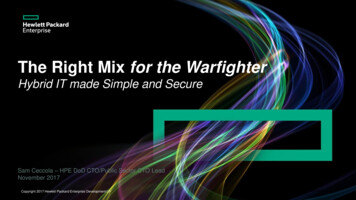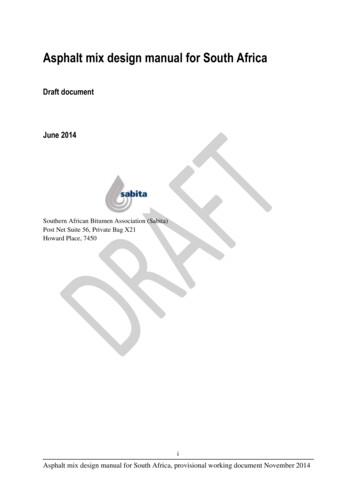
Transcription
The Right Mix for the WarfighterHybrid IT made Simple and SecureSam Ceccola – HPE DoD CTO/Public Sector CTO LeadNovember 2017 Copyright 2017 Hewlett Packard Enterprise Development LPConfidential – For Training Purposes Only
AGENDA– Hybrid IT: Establishing a Common Definition and Why it’s important– Drivers for a Hybrid approach to IT– The Right Mix and Right Model– Enablers for Hybrid IT– Current Challenges and Priorities for Delivering IT in the DoD– Solutions to the Challenges and Priorities of the DoD– Conclusions
Hybrid IT: Where are you running yourworkloads?
Hybrid ITIndustry definition:Alternate definition:Hybrid IT: An approach toenterprise computing in whichan organization provides andmanages some informationtechnology (IT) resources inhouse but uses cloud-basedservices for others.Differentiator: Hybrid IT is anapproach to enterprisecomputing in which anorganization movesworkloads from aninfrastructure with oneparticular set ofcharacteristics to anotherseamlessly in order tooptimize security,performance, outcomes andcost.4
The World is moving to Hybrid and HPE’s strategy positions you to winFlexibleconsumptionBeacons, sensorsand geo-positioningDriven by agileDevOpsMobile users,apps and devicesEcosystem ofinnovation partnersReliableperformance& experienceHybridITYour Apps& kloadoptimizedSecurity &resilience built-inContainerized, automatedand orchestratedServicesBuilt-in data analysis& contextually awareAdaptive trustsecurityConfidential – For Training Purposes Only
Drivers for Hybrid AdoptionConfidential – For Training Purposes Only6
Hybrid IT: the balancing actFinding your “right mix” and “right model”The “Right Mix” is not a static destination, but rather part of the dynamic Hybrid IT Journey As technology, requirements, threats and other variables change, so will the “Right Mix”
HPE IT transformation original objectives and actual resultsOur Right Mix defined, powered, and optimizedCloudTraditionalTraditional ITAutomate &virtualizePrivatecloudsManagedcloudsPublic clouds SaaSOn Premises7,000 Apps7,000 Apps1,800 AppsOff e, mainframe& non-virtualized appsCloud native apps &traditional appsmigrated to cloudBroker M/S Azureservices throughcommon service portalSaaS: HR, CRM,ERP, Content Mgmt– Workload suitability– Cloud “lock in” AWS and Azure– Application readiness– Data security concerns– Cost concerns (public cloud)– Desire for controllable costs– SLA, High availability
IT has choices to optimally place new and legacy workloadsOn PremisesPublic CloudControl & governanceSecurity & complianceScalabilityData sovereigntyVariable expenseArchitectural choiceSimpler IT operationLatencyDeveloper-centricFlexibilityVendor Lock-InHybrid ITThe right mix9
Workload placement considerations60 areas of �––––––––Data Retention Requirements–Cloud acceptanceSLA / business continuity–Growth projections–Industry trends / best practicesShadow ITService providers–3P and vendor contractsData protection requirements–Network isolation requirements–Audit standards requirements / log–Retention–Time to marketBusiness criticality–Governance–User experience expectationsUser base location / geographyApplication continuity / forecastFinancial– Performance requirements:compute, network, storage– High availability requirements– Server to admin ratiosClustering stackSoftware licensing– Network requirementsDevelopment– Virtualizationcosts―applications– Application tier– Current and future state– Storage requirements– Lift and evolve– Storage distributionMaintenance costs– Application trends– Facilities costsLife-cycle management costs – Utilization– Load balancingHosting costs– Geography localizationInfrastructurerequirementsNet new revenue stream–Parallelism and scalabilityopportunities– Distributed architectureTime to value– Application environmentsRepatriation of workloads(functional environments)– Infrastructure services– Monitoring and managementMigration costs―one timeOperating �–SecurityServer inventoryDependency mappingSecurity requirementsInfrastructure servicesInter-application latencyAssetsApplication routing and DNSLoggingMigration complexityApplication review– Compliance requirements,regulations– Security Accreditations– Data Sensitivity andCompartmentalization– Security standards– DFARS and other regulations– TAA Compliant– Made in the USAFor HPE and Channel Partner internal use only10
What about as a Service: Why should I care about procurement?Save on costs due to overprovisioning Enterprisesofoverprovisionon averagebyor59%enterprises wait3 monthslonger for new capacity59% for compute and48% for storageCompute needed and avingsTraditional purchases (CAPEX)BufferCapacity ahead of demandMaintain a safe buffer of capacity50% experienced downtime due to capacity planning57% received complaints of slow performance11451 Research November 2016Time11
Cloud economics - pricing comparison2 vCPU x 8 GB RAM virtual machine―public versus on-premises**HPE Synergy―50% lower costthan public cloudsHPE Synergy Medium (Flex Capacity)Amazon EC2 3 year reserved - m4.LargeAmazon EC2 1 year reserved - m4.LargeGoogle Compute Engine - n1standard-2Amazon EC2 On Demand - m4.LargeMicrosoft Azure - D2 v2Ibm Softlayer0Based on Cloud Genera workloadplacement engine on 17 April 2017.0.020.040.06 0.080.10.12Price per VM per hour0.140.160.18Facilities, admin, power, and cooling pricing are excluded and vary by customer; can range from 0 to .01 for greenfield/hour.** Based on available public cloud pricing. Configurations and unit pricing for public provider comparison as of 4-17-2017. Supporting data provided upon request.For HPE and Channel Partner internal use only12
Drive Results & EfficiencyTargeted savings across compute, storage, backup and DRHybrid IT Data solutionsGuaranteed Data EfficiencyBuilt-in Resiliency, Backup, andDisaster RecoveryGlobal VM-Centric Managementand Mobility Compression and deduplication Data processed at inception, globally Guaranteed 90% capacity savings across storage and backup Software defined: Manage all resources in a federated pool Seamlessly move data across on prem and off prem Eliminate islands IT Consumption: XaaS Pay as you goHPE customers can average 40:1 data efficiency andoften see greater than 50% performance improvement13
Enablers for Hybrid IT– Data Security, Product Security and Secure Supply chain– Workload Portability and Container Technology– In Memory Compute and Memory Centric Architecture– Cloud EconomicsConfidential – For Training Purposes Only14
The Customer: DoD Challenges and Priorities
Common IT challenges across the Department of Defense– Security– Skilled manpower and training– Risk averse, slow to adopt new technologiesand approaches paralysis through analysis– Lack of adequate funding and/or wrong colorof money– Acquisition process is not agile or responsiveto IT needs– Interoperability– ITSM and ITAM– Outdated regulations and policies
Hybrid IT Satisfies Top IT Priorities! Improve Cybersecurity: Deliver baked-in security features, simplified O&M, fewerseams, persistent monitoring and a reduced surface attack profile Reduce IT spending and Improve accountability: Have an Agile Hyrbid ITDeployment that optimizes workloads for the mission outcomes Consolidate Data Centers and Automate: Outsource Enterprise IT systems and services via COCO model; and Leverage automation and simplify management; realign limited uniformed cyber forces tohigher-priority governmentally inherent positions Agile: Leverage automation, containerization and composability to become workloadagnostic, drive desired outcomes and improve IT and operational agility Cloud First: Embrace Hybrid IT, promote agility and avoid vendor lock-in
Conclusions and Call to Action– DoD should not be in the Infrastructure Business – However, you shouldcare about the infrastructure and define requirements and salientcharacteristics to deliver operational capability and mission assurance– DoD should adopt a COCO Model and fully embrace XaaS– Hybrid IT is not defined by on-prem/off-prem, but by the optimizedenvironment / ecosystem hosting and running the workload(s)18
Thank you
Ibm Softlayer Microsoft Azure - D2 v2 Amazon EC2 On Demand - m4.Large Google Compute Engine - n1standard-2 Amazon EC2 1 year reserved - m4.Large Amazon EC2 3 year reserved - m4.Large HPE Synergy Medium (Flex Capacity) HPE Synergy― 50% lower cost than public clouds Price per VM per hour For HPE and Channel Partner internal use only











